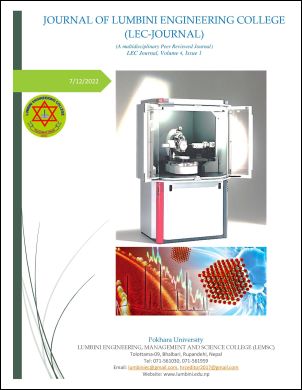Hydraulic Analysis of Lekhnath Small Town Water Supply Distribution Network, Pokhara Metropolitan City, Nepal
DOI:
https://doi.org/10.3126/lecj.v4i1.49360Keywords:
EPANET, Genetic Algorithm, Hydraulic Analysis, Water Distribution Network (WDN), Water Supply and Quality Monitoring, Reliability, Youth-led InitiativeAbstract
Water Distribution Network earlier will have challenge in fulfilling the growing need of water supply. Forecasting and monitoring the flow, pressure, demand, and quality of water in water distribution network are key requirement for sustainable and reliable water supply. Lekhnath city, due to the recent merger with the biggest metropolitan city of Nepal, Pokhara, has created the rapid growth of population resulting to haphazard pipeline extension in this area. For hydraulic analysis of Lekhnath Small Town Water Supply Distribution Network, one of the networks i.e., Shishuwakhudi distribution network was faced with problem analysis. This hydraulic analysis is a part of on-going doctoral research and Youth-led Initiative ‘drinkPani’ on ‘Water Supply and Quality Monitoring using Emerging Technologies’ where capacity building of Youth and Women through data-driven engagements (Water-informatics) is one of the core targets in the overall project-work package. The preliminary analysis of water quality was also derived from Young Water Volunteers (YWVs) under the research work on Youth-led Participatory Sensing (YPS) Model to enhance drinking water security of the study area. The Shishuwakhudi Water Distribution Network (WDN) supplies water to 1138 household at present and consisting of 41 junction nodes and 11.2km distribution pipeline distributing water from a reservoir. With field survey, households at each node of the network were determined. Demand driven analysis using EPANET was done to determine the pressure deficit at various nodes. Demand pattern based on design guideline was adopted for analysis. At present scenario, four nodes at end of the network showed negative pressure at peak hours (5 am- 7am). At other times, the pressure was above 10m head. Demand was forecasted for 10 years from now by projecting the household population based on growth rate of census 2011. When projected to future scenario, the existing pipeline showed only 17% reliability with a minimum pressure requirement of 10 m head as per norms of urban water supply project in Nepal. Genetic algorithm was used for optimization of the Shishuwakhudi Network with total cost of replacing pipes as an objective function with pressure constraint of minimum 10m head. With 500 generation of run, the optimal diameter for each pipe was obtained that gave optimal cost of NRs 4,21,50,917 (USD 359,690.64). This optimization helps in selecting the proper pipeline network for future expansion to fulfil the growing need of water demand.
Downloads
Downloads
Published
How to Cite
Issue
Section
License
Copyright (c) 2022 LEC Pokhara University

This work is licensed under a Creative Commons Attribution-NonCommercial 4.0 International License.
This license allows reusers to distribute, remix, adapt, and build upon the material in any medium or format for non-commercial purposes only, and only so long as attribution is given to the creator.




